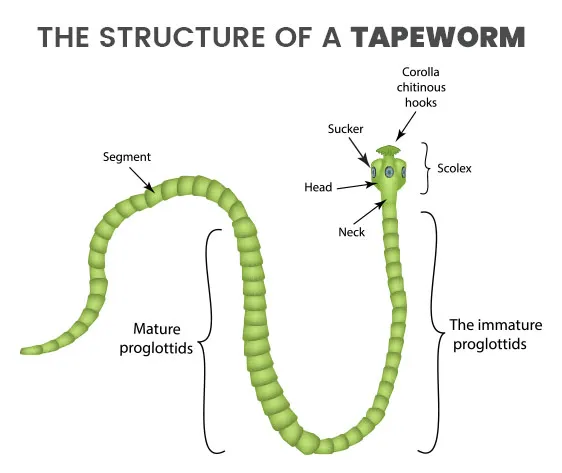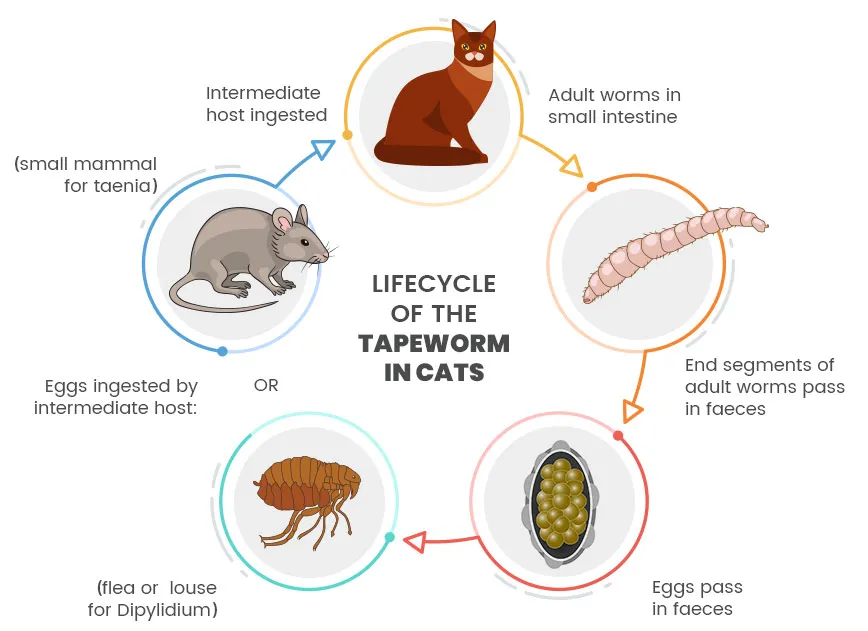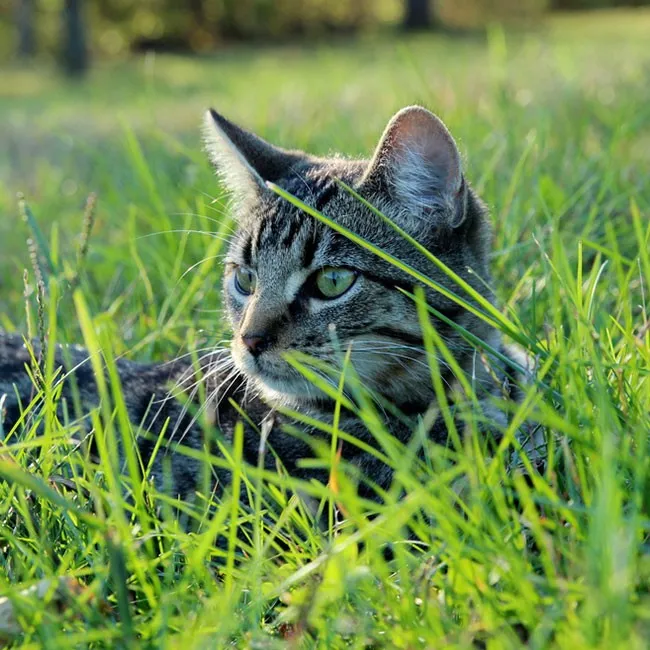How to Deal With Tapeworms in Cats
As tapeworms are one of the most common intestinal worms for cats, they’re, unfortunately, something you need to know about. These horrible parasites are very easy for your cat to get, as a single tapeworm can create somewhere between 1,000-2,000 proglottids (tapeworm segments with individual reproductive systems) with a total of a huge 100,000 eggs! This makes them a big issue for many cat owners, and to make it even more serious, this is a type of worm that can also be passed to humans. To help you understand tapeworms in cats as well how to recognise them, how they live in a cat’s digestive system and then the best way to deal with them, keep reading.
As tapeworms are one of the most common intestinal worms for cats, they’re, unfortunately, something you need to know about. These horrible parasites are very easy for your cat to get, as a single tapeworm can create somewhere between 1,000-2,000 proglottids (tapeworm segments with individual reproductive systems) with a total of a huge 100,000 eggs! This makes them a big issue for many cat owners, and to make it even more serious, this is a type of worm that can also be passed to humans. To help you understand tapeworms in cats as well how to recognise them, how they live in a cat’s digestive system and then the best way to deal with them, keep reading.
What are tapeworms?

Tapeworms are a type of parasite. This means they live off of a host and need them to survive. As a result, they either live in an intermediate host or in the intestines of a cat (or other larger animals such as dogs and people). Although parasitic creatures, compared to other types of intestinal worms that literally suck the host’s blood, tapeworms are less dangerous than many and as a result, show less noticeable symptoms. You will most likely realise your cat has worms when noticing the visible segments in the stool. There are many different kinds of tapeworms, each with their own characteristics and intermediate hosts, meaning there are multiple ways for your cat to get them.
Types of Tapeworms
| Official Name | Intermediate host | Can humans get them? |
|---|---|---|
| Dipylidium Caninum | Fleas | Yes - From a contaminated flea |
| Taenia Hydatigena or Taenia Multiceps | Pigs, sheep, and goats | Yes - From contact with a dog with the worm |
| Taenia Pisiformis or Taenia Serialis | Rabbits and rodents | Yes - From infected beef |
| Echinococcus | Wildlife & livestock (e.g cattle & sheep) | Yes - From contact with a dog with the worm |
| Diphyllobothrium | Wildlife & raw/undercooked fish | Yes - From raw or undercooked fish |
What do tapeworms look like in cats?
Mature tapeworms are long flat worms that can grow anywhere from 4-8 inches long. The majority of their body is made up of proglottids, or little segments. These contain their own reproductive systems with eggs that break off from the main body in order to pass through the stool and then reproduce. When recently passed they appear as small white fragments, almost like a grain of rice. After a while though, they’ll dry out and look like yellow hard specks. These will most commonly be found on your cat’s bedding or on the fur around their anus. These segments are the most common way you will see a tapeworm; when fully grown they live within your cat’s intestines and it is very unlikely for the full tapeworm to pass in the stool without treatment.
How do cats get them?
Tapeworms are one of the most common intestinal worms as they have a wide variety of intermediate hosts. These are hosts that hold the tapeworm larvae. Once a cat ingests one of these intermediate hosts, the larvae are passed onto your cat where it matures within their intestines. A cat cannot be infected directly through the egg, so an intermediate host is required for all kinds of tapeworms, making them slightly different to other types of intestinal worms.
The typical intermediate host for tapeworms in cats is infected fleas. These are very easy for your cat to accidentally ingest, especially as fleas are another popular problematic parasite for cats. There are many others to watch out for though, including rodents, rabbits, birds, wildlife, farm animals, cattle and even undercooked or raw fish. This doesn’t mean you need to avoid these at all costs though; it simply means that there are a number of potential hosts so take sensible precautions. This can be by just avoiding dead animals and thoroughly cooking meat or fish before feeding to your cat. Basically, if you wouldn’t eat it yourself, don’t give it to your cat!
Signs and symptoms
So now you know where they come from, what are some of the signs of tapeworms in cats you should be looking out for? As tapeworms don’t require as much nutrition as others to survive, they don’t usually have a large number of symptoms. The most obvious is visible tapeworm segments in your cat’s stool or on the fur around their anus. A severe tapeworm infection, however, has been known to have some more serious signs. Your cat may appear to lose weight even though they’re eating the same and they may also vomit up the worm if it makes it’s way to their stomach. Weight loss and vomiting aren’t necessarily only attributed to tapeworms symptoms in cats though, so it is important that you can rule out any other potential health problems before trying any kind of treatment. If you are unsure, the best option would be to consult your vet.
How to get rid of tapeworms in cats
If you know your cat has a tapeworm, there are now some things you can do to help get rid of them. The most popular choice is a tapeworm treatment for cats. These can be found online or through your vet. If it is a large infestation, then there your vet may suggest a serious tapeworm medicine for cats that works to kill the tapeworm so it can be safely passed in the stool, but without harming your cat. This is one of the best answers to the question ‘how to treat tapeworms in cats’ as they can help to get rid of existing worms
Methods of prevention
- Use a preventative cat dewormer
- Flea control
- Avoid the intermediate hosts
- Clean their living areas
- Wash hand when spending time outside
If your cat already has a tapeworm, then you’ll need to get rid of it as soon as possible. The best way, however, to truly deal with tapeworms in cats is to take preventative measures to reduce the risk of your cat getting them in the first place. You can start by using preventative products that have been specifically designed to help deal with tapeworms. These vary in their types (from tablets to powders to drops), but if used correctly can be very useful. The best of these are herbal cat dewormers that work to naturally support cat’s intestinal function to make it an uninviting living environment for worms. These can additionally be great as they can work for a number of intestinal worms found in cats alongside tapeworms.

Secondly, you can make sure you practice good flea control; fleas are the most common intermediate hosts for tapeworms so if your cat can avoid fleas, that have a better chance of avoiding tapeworms. Similarly, you can try preventing tapeworms in your cats by also avoiding the other potential intermediate hosts. This can be by not letting your cat bring in mice or bird, not feeding them scraps of raw meat and avoiding any known areas that have contaminated animals.
Finally, it is important that you keep their living environments clean and tidy. This is especially important if your cat has already had tapeworms and you want to stop them from returning. To do this, simply make sure to keep your cat regularly washed and groomed, keep their bedding clean and pick up their stool. Furthermore, if you have any other pets that could have worms make sure to treat them too and if you have children that like to play outside, make sure they wash their hands.





















